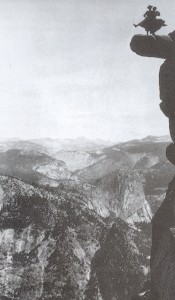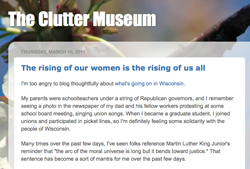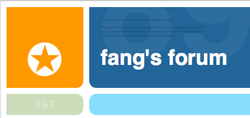 What do you get when you mix iPads, old taxidermy, hair ornaments, and a near-complete disregard for one’s own pedagogical tradition?
What do you get when you mix iPads, old taxidermy, hair ornaments, and a near-complete disregard for one’s own pedagogical tradition?
My spring course, History 346: Women in the American West.
It’s the first time I’ve taught the course, and I’ve decided to throw caution to the wind.
Thumbnail
40 students, upper-division History, cross-listed with Gender Studies. Books by and about women.
In
Squatters on Mexican land grants in California. Women Zoot suiters. Manzanar. Dorothea Lange. A hundred years of Chinese Americans. Native American activism. Museum artifacts, some made from human hair. Also probably some taxidermy. Plus: an iPad2 on loan to each student. Several one-page reflection papers. One giant group project.
Out
Covered wagons, bonneted pioneers, Sacajawea, Oregon Trail, Donner party. Individually authored, end-of-course research essays.
The project I suspect makes some of my colleagues think I’m not playing with a full deck
My students are going to construct an online experience (I’m looking for a better word–exhibit doesn’t quite do it for me) about the history of Idaho women’s amateur arts and crafts. They’ll be drawing on frequently uninterpreted objects from the collection of the state historical society: needlework, ornaments made from human hair, quilting, beading, plein air painting, taxidermy, sewing (clothing), and whatever else we find in storage or on exhibit. They’ll have to research and document these artifacts, take and edit photos, correspond with experts, write essays about women’s participation in each kind of arts and craft practice, determine on what platform they’d like to build this project (I’m guessing WordPress or Omeka, but maybe they’ll surprise me), break down the work across several smaller groups of students, create a timeline to ensure the exhibit is complete, build the damn thing, and put in place quality assurance protocols.
Each student is being loaned an iPad2 for the semester by the university’s academic technologies office, under the auspices of its Mobile Learning Scholars program. This is my second year as an m-learning scholar.
But basically, yeah, I’m giving the students shiny new devices and asking them to engage in a 40-person, high-stakes group project.
Hey look—I have research questions
1. In what ways does the student practice and presentation of western U.S. women’s history—often represented in its raw form through sometimes difficult-to-interpret everyday objects and letters rather than through political and business documents—benefit from an approach that emphasizes collaborative research and interpretation; technology that allows for a media-rich interpretive experience (including, for example, a closer, relatively three-dimensional examination of artifacts than is afforded by a museum exhibit); and an engagement with potential audience members through social media from the moment of a project’s conception?
2. How does the use of tablet computers influence the depth and breadth of student collaborations and the quality of the work resulting from these collaborations?
Inspirations
- Frustration with how I’ve evaluated student work in the past (so much grading, and What Really Matters gets thrown into question)—and solutions brought to me in part by thinking about the fox in the video game.
- Martha Burtis and Jim Groom of ds106 fame. This project is far less ambitious and considerably less wacky than their grand and highly successful experiments, but it has its creative roots and insistence on student responsibility and ownership of learning technologies in the experiments going on at the University of Mary Washington these last several years.
- Also: Alan Levine‘s insistence on constantly creating, iterating, and sharing.
Anticipated challenges
- Persuading students not to jump ship or panic when I tell them a good deal of their grade is based on the Mother Of All Group Work.
- Convincing students, once and for all, not to form their smaller groups with the people who happen to be sitting next to them that day. (Will they never learn, despite my repeated warnings?)
- Showing students that there are indeed connections between the readings and the Mother Of All Group Work.
- Getting students to be reflective about women’s history, public history, and their anxieties about creating stuff with technology—without sounding all touchy-feely. (“Get in touch with your inner PHP learner. . . What is she afraid of? What can you do to help her?”)
- Not overwhelming the museum’s fabulous curatorial registrar, who is also one of my grad students, and who is also trying to mount her own exhibit and graduate this spring.
- Getting IRB approval to study my students’ collaborations and publish the results. (In progress. . . The paperwork is a headache and a half, as it forces me to be all social-sciencey in a way with which I’m not comfortable.)
I’m at once excited about the course possibilities and dreading finding out the multiple small ways in which it will inevitably go off the rails. Wheeeeeee!
Assuming the semester doesn’t get too busy and stressful (ha!), I’ll blog about the course here at The Clutter Museum.
What are you looking forward to (or dreading) about your projects or classes over the next several months?


sounds fascinating. I’ve never done it with the tech aspect but with the right students the MOAGP can totally work and it sounds like you have a FAB plan. Looking forward to hearing about the results (provided it doesn’t keep you too busy to blog
That sounds like a fascinating class, and a very bold leap in the dark you’re making! For about two seconds it made me miss teaching.
Your course sounds great! Hopefully we can view your students’ final project! I am teaching a new course on digital tools in health professions this spring. I am planning for it to be an an exploration of a variety of tools to support professional activities. I have left the project work and assessment flexible so students have the opportunity to design their own learning experiences. While I have been excited about this flexible approach, I am now getting a bit nervous because it is hard to know how things will progress. Your mobile scholars program sounds great! Best wishes for a successful course!
THIS sounds FABULOUS! Hoping you DO blog about it 😀
What everyone else said: this sounds amazing, and I really want to hear more; I’d love to do substantive group work in (at least a few of) my classes, but have never gotten up the nerve to do so. Please do keep us in the loop about its practicalities and its results.
Me, I’m apprehensive about teaching composition to “regular” comp students for the first time in 3.5 years (I’ve taught Honors kids the last two times I’ve taught comp), and with a totally new syllabus/set of assignments designed around issues of legal and judicial reform (a subject in which I have only a strong amateur interest).
Mal was looking up courses and said “this sounds really cool, but probably beyond me right now.” Then she realized it was your’s. I think in the end it didn’t work with her schedule, but she was REALLY interested.
I think in the end it didn’t work with her schedule, but she was REALLY interested.
oh, Lisa’s comment answers a question I posed to her on twitter a couple weeks ago. (and which she didn’t answer)
(and which she didn’t answer)
Anyway, this sounds FANTASTIC!! And it reminds me a bit of my own class, but yours is WAY more adventurous ;). I just WISH my students could have ipads so I could assign more texts for them to read on PDF (not that they’d read them, right?) I want to come back and read the post more carefully because I want to know more about this class. I hope you can write other posts about it.